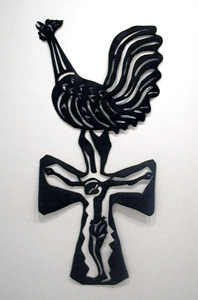|
Exhibition on view from January through February 2006.
As a medium, Haitian iron sculpture is a little more than a half-century old, a genre of that miraculous florescence of art now called "the Haitian Renaissance." But as the material expression of a nation's culture, Haitian sculpture is much older than that; its roots go back to Africa, to those old world liturgical myths and rituals which were melded into Vodou, Haiti's national religion. Originally inspired by the ritual needs of Vodou, Haitian Artists continue to produce objects that represent, invoke, contain, assuage, channel or divert the energies of the Iwa as the divinities of Vodou are called in Kreyol, Haiti's vernacular language.
 |
Murat Brierre (1938–1988) |
George Liautaud (1899-1991) is considered the pioneer of Haiti's most important art making-metal sculpting. A profoundly spiritual man, Liautaud, began making grave yard crosses while he worked as a railroad repairman and a blacksmith. He experimented with an array of techniques all involving iron from oil drums some simple flat cut out sheets of iron but some more elaborate representations of Christian and Vodou themes. Liataud was an active believer in Vodou and within that tradition, in the significance of metal. Liautaud inspired a generation of artists who continue to work and build upon this tradition. Perhaps Liautaud's greatest achievement is giving form to that most shattering of human experiences: spirit possession.
Murat Brierre (1938-1988) is considered one of Haiti's principal metal sculptors and the first disciple of George Liautaud. He worked as a mason, cabinet worker and blacksmith. Although he also painted, Brierre chose to concentrate on iron because of his belief that metal is imbued with spiritual powers, a central belief of the Vodou religion.
Joseph Louisjuste and his brothers began working under George Liautaud and became known as the second generation of artists working in iron. Much of his work is imbued with a playful and humorous element. Continuing the tradition, Serge Jolimeau (1952-) and Gabrial Beinamie (1951-) are somewhat younger. Beinamie experimented on more complex metal surfaces, twisting and layering metal parts and Jolimeau opens out the imaginary itself into new worlds of surreal creatures. On Jolimeau's huge metal canvasses everything seems to come alive: fabulous creatures writhe into new states of being.
Original source text from the catalog essay by Donald Cosentino for the exhibition, Lespri Endepandan: Discovering Haitian Sculpture at the The Patricia & Phillip Frost Art Museum.

|